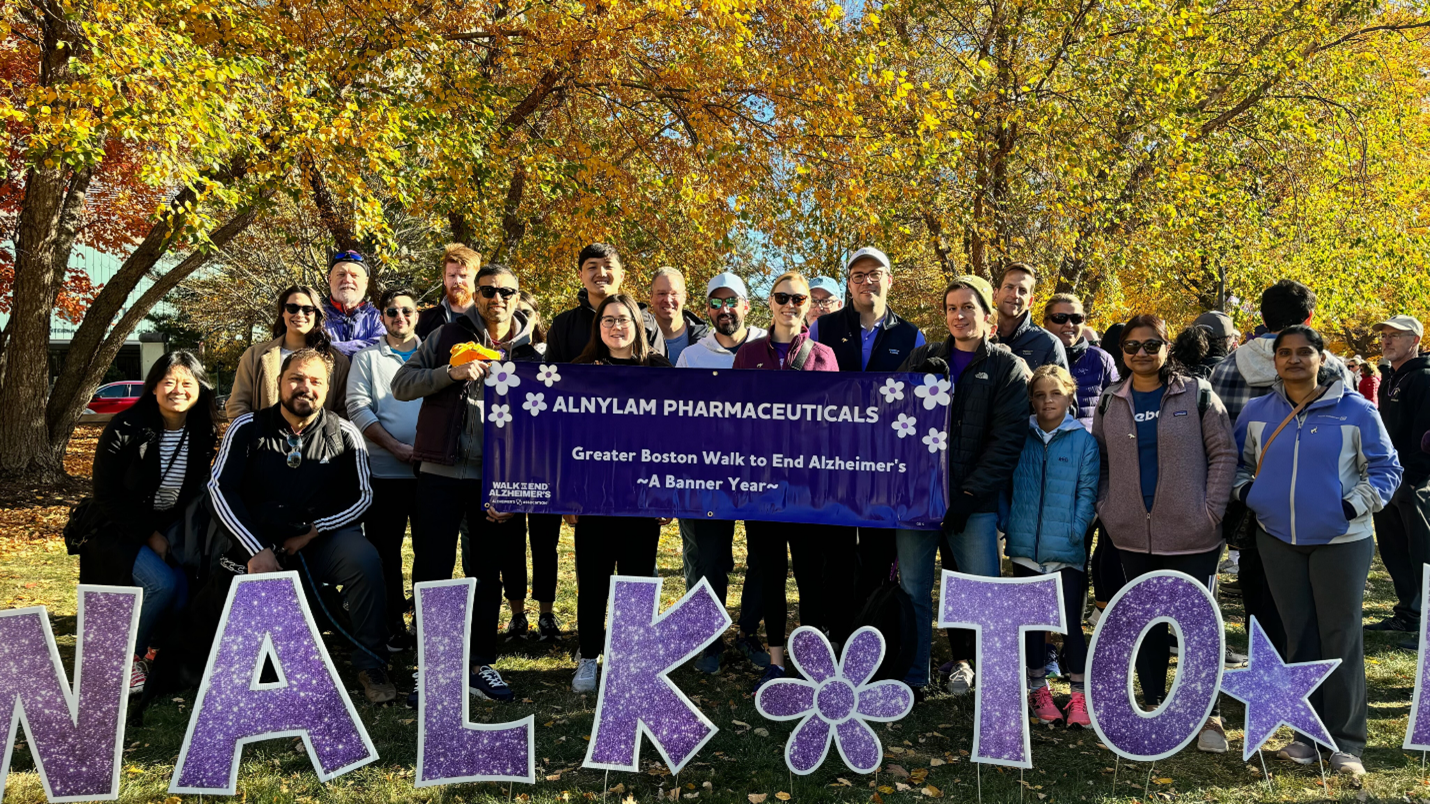
Our News
A New Therapeutic Approach Seeks to Silence Devastating Neurological Diseases
Exploring the potential of RNAi therapeutics to tackle brain diseases with few or no treatments
February 21, 2025
Frances Sloan was once a passionate oil painter who depicted serene landscapes and deftly captured natural light with her brush. She and her husband Neville traveled extensively as part of his military service before retiring to Florida to spend their days by the water. Alzheimer’s disease threw a wrench in their retirement plans. Frances’ memory deteriorated gradually; she struggled to drive, and her personality shifted. Eventually, her family had no choice but to stand by and watch her cognitive decline as she spent the last few years of her life in a locked memory care unit.
 Frances (left) and her husband Neville, who retired as a Colonel in the US Army, traveled frequently during the early part of their lives.
Frances (left) and her husband Neville, who retired as a Colonel in the US Army, traveled frequently during the early part of their lives.The complex functions of our brains comprise much of what makes us human. Losing memories, reasoning, coordination, or disruptions in cognition can be devastating. Neurological illnesses strike right at the core of who we are, robbing us of joy, dignity, and independence. And despite the enormous need for treatments to halt neurological diseases and reclaim our humanity, relatively few exist.
Kevin Sloan, Vice President of Development Programs at Alnylam and Frances’ grandson, is driven to help develop new treatments for neurological diseases, saying, “I know from experience that families urgently need treatment options. For me, this work is personal.”
The Outsized Impact of Neurological Diseases
One-third of the global population is affected by neurological disease, the leading cause of disability worldwide1. Diseases of the nervous system include dementia, movement disorders, stroke, psychiatric disorders, and headaches, among many others.
Many neurological diseases have no or few available treatments, many of them inadequate. Researchers and drug companies have long been thwarted by the complexity of the central nervous system (CNS), side effects of potential treatments, and difficulty delivering medicines to the brain.
With so many hurdles, the success rate of developing medicines for neurological diseases is substantially lower than for other diseases2. Available treatments tend to focus on improving the symptoms of neurological disorders rather than addressing their underlying causes.
When Frances was diagnosed with Alzheimer’s disease, her family sought medical interventions. They came up empty handed, feeling there was no option but to let the disease take its course – and claim Frances’ spirit. They felt they were just biding time, a feeling felt by many of the 55 million people around the world living with Alzheimer’s disease and their families.
For these families, and more importantly, the patients they love and care for, new treatment approaches are desperately needed. RNA interference (RNAi) therapeutics, which are a type of gene silencing medicine, could be part of the solution.
 Alnylam’s Kevin Sloan visited his grandparents Frances and Neville each summer in Florida
Alnylam’s Kevin Sloan visited his grandparents Frances and Neville each summer in Florida Exploring New Therapeutic Approaches
To address the root causes of CNS diseases, the challenge has been developing the right tools and getting them to the right place. Fortunately, scientists are armed with more knowledge than ever about the genetic drivers of neurological diseases, including complex diseases such as Alzheimer’s disease. Proteins accumulate as amyloid plaques and tau tangles during the progression of Alzheimer’s disease; in advanced stages, brain cells die, leading to tissue loss.
RNAi therapeutics are a well-established class of medicine that can silence the genes that drive disease. Whereas most medicines work by modifying disease-causing proteins, which are encoded by genes, RNAi therapeutics prevent these proteins from being made in the first place. If conventional medicines are like mopping up water on the floor from a leaking sink, RNAi therapeutics are like turning off the faucet to stop the leak.
This innovative approach to treating disease is relatively new but has a robust track record of safety and efficacy. RNAi therapeutics have key features that make them potentially powerful weapons in the fight against neurological diseases, including that they are longer lasting than other classes of medicines, often only requiring doses every three or six months – or potentially even less frequently in the future. Approved RNAi therapeutics—including five discovered by Alnylam—have already helped tens of thousands of patients suffering from rare and common illnesses. And RNAi therapeutics have the potential to silence an even wider range of diseases.
Alnylam has taken on progressive neurological diseases with RNAi therapeutics before. The company has developed two approved drugs to treat polyneuropathy due to hereditary transthyretin amyloidosis (hATTR). As a treatment for the polyneuropathy of hATTR, RNAi therapeutics aim to reduce the buildup of disease-causing amyloid proteins made in the liver to reduce patients’ symptoms and improve their quality of life.
Now the company is working to expand its efforts in neurology by delivering RNAi therapeutics to the CNS. Finding a way to get drugs to the brain is not easy. However, Alnylam’s researchers have recently established the first proof of concept for delivering RNAi therapeutics to the human brain in a small clinical trial.
“The history of Alnylam has centered around solving engineering challenges. We were the first to figure out ways to deliver RNAi therapeutics to the liver,” says Kirk Brown, Vice President of Research at Alnylam. “Now, we’ve unlocked RNAi therapeutic access to the brain.”
Brown’s team showed in preclinical models that RNAi therapeutics reached deep brain tissues to reduce the levels of key proteins in the brain, and the effects lasted for months. This encouraging data paved the way for clinical trials to assess RNAi therapeutics’ potential to impact devastating brain diseases, including the first evidence of gene silencing with an investigational RNAi therapeutic in the CNS in patients.
 The Sloan family gathered in 1998, with one of Frances’ oil paintings behind them. From left to right, Neville, Bill (Kevin’s father, and Frances and Neville’s son), Kevin, and Frances.
The Sloan family gathered in 1998, with one of Frances’ oil paintings behind them. From left to right, Neville, Bill (Kevin’s father, and Frances and Neville’s son), Kevin, and Frances.Early Hope for Silencing Neurological Diseases
That first evidence came in a small, ongoing clinical trial in patients with early-onset Alzheimer’s disease. Patients treated with an investigational RNAi therapeutic targeting amyloid precursor protein (APP) experienced rapid and sustained reduction in the levels of APP fragments measured in the cerebrospinal fluid, a finding reported by Alnylam in 2023. Patients in the trial have now received more than one dose of the investigational RNAi therapeutic, and the potential for a strong safety profile is emerging, giving researchers confidence to expand applications of the technology.
A phase 2 clinical trial is now testing this investigational RNAi therapeutic to see if it can help in a disease called cerebral amyloid angiopathy (CAA), a leading cause of strokes in older adults3. Additional investigational RNAi therapeutics have also entered the clinic. For example, Alnylam is conducting a phase 1 clinical trial in collaboration with Regeneron for an RNAi therapeutic that may have potential as a future treatment for Huntington’s disease (HD), and they are exploring another potential RNAi therapeutic targeting the tau protein that could soon enter clinical trials for Alzheimer’s disease. In partnership with Alnylam, Regeneron is developing an RNAi therapeutic targeting SOD1, which may help a subset of patients with amyotrophic lateral sclerosis (ALS). The collaboration between Alnylam and Regeneron, in place since 2019, has helped to accelerate drug discovery and development in neurology.
Sloan, Frances’ grandson, leads the HD development team. He feels optimistic about the possibility of RNAi therapeutics to treat diseases like HD that currently have no disease-modifying treatments.
“It will take time,” says Sloan. “With new therapeutic approaches on the horizon, I believe we are closer to modifying the devastating course of many neurological diseases – truly bringing new hope to patients.”
 Alnylam team members attending the Boston Walk to End Alzheimer’s in 2023
Alnylam team members attending the Boston Walk to End Alzheimer’s in 20231. Steinmetz, Jaimie D et al. Global, regional, and national burden of disorders affecting the nervous system, 1990–2021: a systematic analysis for the Global Burden of Disease Study 2021. Lancet Neurology. 2024 23;4: 344 – 381.
2. Gribkoff VK, Kaczmarek LK. The need for new approaches in CNS drug discovery: Why drugs have failed, and what can be done to improve outcomes. Neuropharmacology. 2017 Jul 1;120:11-19. doi: 10.1016/j.neuropharm.2016.03.021.
3. Viswanathan A, Greenberg SM. Cerebral amyloid angiopathy in the elderly. Ann Neurol. 2011 Dec;70(6):871-80. doi: 10.1002/ana.22516.





